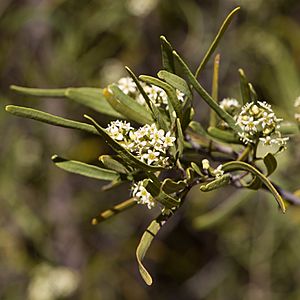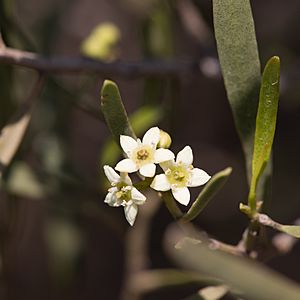Oilbush facts for kids
Quick facts for kids Oilbush |
|
|---|---|
 |
|
| Scientific classification | |
| Genus: |
Geijera
|
| Species: |
linearifolia
|
The oilbush (scientific name: Geijera linearifolia) is a type of shrub found only in southern Australia. It's also sometimes called sheepbush. This plant is part of the Rutaceae family, which also includes citrus fruits like oranges and lemons!
The oilbush has simple, narrow leaves. It produces many small, greenish-white flowers grouped together. After the flowers, it grows fruits that hold a shiny black seed inside.
Contents
What Does the Oilbush Look Like?
The oilbush is an upright, bushy shrub that usually grows between 1 and 3 meters (about 3 to 10 feet) tall. Its leaves are long and narrow, sometimes shaped like an egg but narrower at the bottom. They are about 1.5 to 6.5 centimeters (0.6 to 2.5 inches) long and 2 to 5 millimeters (0.08 to 0.2 inches) wide. Each leaf has a short stalk, about 2 to 5 millimeters long.
Oilbush Flowers and Fruit
The flowers of the oilbush are smooth and grow in clusters. These clusters are about 1 to 3 centimeters (0.4 to 1.2 inches) long. Each tiny flower sits on a small stalk, about 1 to 3 millimeters long. The petals are egg-shaped and are white to greenish-white, measuring about 1.5 to 2 millimeters long.
Oilbush plants usually flower from August to October. After flowering, they produce fruits that are about 4 to 6 millimeters long and 3 to 4 millimeters wide. Each fruit contains a single, shiny black seed.
How the Oilbush Got Its Name
The oilbush was first officially described in 1824 by a scientist named Augustin Pyramus de Candolle. He gave it the name Eriostemon linearifolius. Later, in 1924, another scientist named John McConnell Black changed its name to Geijera linearifolia, which is the name we use today.
Where Does the Oilbush Grow?
You can find the oilbush growing in rocky areas with limestone, especially on flat lands and around the edges of salt lakes. It prefers woodlands and dry scrub environments.
This shrub grows across a wide area in southern Australia. It can be found from a place called Lake Kirk in central-southern Western Australia, all the way to the Murray River in South Australia.
Is the Oilbush in Danger?
The good news is that the oilbush is not considered to be in danger. The Government of Western Australia's Department of Parks and Wildlife has classified it as "not threatened." This means there are enough oilbush plants in the wild for now.


